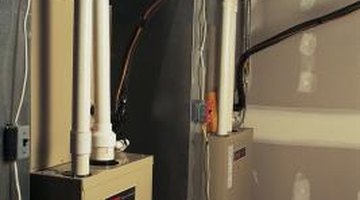What Is a Firebox in a Boiler?
The firebox in a boiler is a chamber where fuel, typically gas or oil, is burned to heat the boiler’s water to the boiling point for use as hot water or steam. A firebox is designed for burning a particular type of fuel. Conversion to a different type of fuel requires a different type of burner and could require changes to the firebox size and shape.
Boiler Types

Boilers come in fire tube and water tube types. In a fire tube boiler, water surrounds the firebox and a group of flue tubes that exhausts the hot combustion products. The energy radiated by the firebox flames and by the hot combustion products flowing out through the flue tubes heats the water surrounding them by conduction. In a water tube boiler, the tubes contain water to be heated by the fire in the firebox and by the hot combustion products rising past the water-filled tubes.
Fuel Air Mix
In both types of boiler, air and fuel enter the firebox for combustion. Complete combustion in the firebox requires the proper mix of fuel and air. Too much fuel or too little air will result in wasted fuel and production of deadly carbon monoxide gas. It takes 1,600 to 2,000 cubic feet of air to completely burn one gallon of No. 2 fuel oil. It takes 10 to 15 cubic feet of air to burn 1 cubic foot of natural gas.
High Efficiency
Modern high-efficiency, gas-fueled condensing boilers for home heating feature a sealed firebox that draws cold air for combustion directly from the outside rather than warmed air from inside the house. These units extract maximum heat from the flue gases by sending them through a second heat exchanger that extracts heat from the water vapor in the flue gases. This means these boilers can vent flue gases directly to the outside without need for a draft hood or damper that would otherwise be needed to keep the flue temperature at safe levels. Sealed combustion gas furnaces can achieve an efficiency rating exceeding 90 percent.
Firebox Maintenance
The firebox and flueways of an oil-fired boiler can accumulate soot that can reduce heat transfer and thereby reduce efficiency. You can remove it from the flueways of the heat exchanger with a round wire brush. Use a vacuum cleaner and soft-bristle brush to remove soot from the firebox. There are also chemical additives for your fuel oil that claim to clean soot deposits from burners, fireboxes and flueways. For gas boiler firebox maintenance, remove the burners and clean them of dirt and combustion deposits, clearing all openings. While the burners are removed, use a vacuum cleaner and wire brush to remove soot or dirt from the flueways of the heat exchanger. Use a bristle brush and vacuum to clean the firebox walls and floor. Replace burners and check the pilot light for proper flame.
Writer Bio
Herb Kirchhoff has more than three decades of hands-on experience as an avid garden hobbyist and home handyman. Since retiring from the news business in 2008, Kirchhoff takes care of a 12-acre rural Michigan lakefront property and applies his experience to his vegetable and flower gardens and home repair and renovation projects.
Photo Credits
- Comstock/Comstock/Getty Images
More Articles



